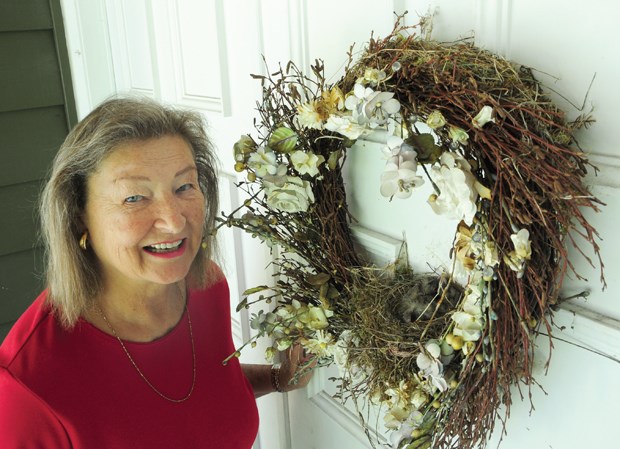Suzanne Wilson opened her front door on June 18 to discover some feathered houseguests had taken up residence on her property.
Cradled in the bottom of her decorative grapevine wreath was a wee robin’s nest with a single blue egg inside.
“They must have built it really fast because we come in and out that front door all the time and all of a sudden it was just there,” the Cloverley resident says.
Two days later, there were three little blue eggs. And on July 6, when Wilson went outside to water her roses, she snuck a peek in the nest and saw hatchlings.
Featherless and with their eyes still closed, the newborns weren’t exactly cute, Wilson admits. “They’re like big, fat brown worms.”
Wilson, her husband, their adult daughter and their young granddaughter have been using the side entrance to the house since discovering the nest, lest they get madly chirped at by the chicks’ protective mother, who keeps watch from atop a nearby swing set.
The family might have to avoid their front door for a little while yet. According to Janelle VanderBeek, care centre co-ordinator at the Wildlife Rescue Association of B.C., the American robin leaves its nest 14 to 16 days after hatching. At that point, it is called a fledgling and it will start learning to fly.
“They’ll be at the stage that they have become cute. They won’t look so much like aliens and naked little babies anymore,” VanderBeek says.
It can take up to two weeks for the fluffy fledglings to learn how to fly and they may be seen awkwardly hopping around on the ground while they get the hang of things.
“Giving them as much space as possible is a really good idea,” she says.
Typically, robins build nests in trees or bushes where they are protected from predators, but urban-dwelling birds are adaptable and the Wilsons’ door wreath probably looked like an inviting nook in which to settle down.
“What they’ve found here is likely a nice sheltered area where there aren’t any crows.”
VanderBeek stresses the importance of leaving a bird’s nest alone if you find one on your property.
“With a lot of different species of birds, some of them will nest close together, and if you move the nest they won’t realize that it’s their nest anymore, they’ll think it’s someone else’s,” she explains.
Residents who have a bird’s nest on their property may want to put out a birdbath, particularly during dry spells, but leaving food out is not advised, VanderBeek says.
“At this time of year there are lots of natural berries and food sources for them,” she says.“If you’re putting out sunflower seeds or something like that, that’s a very high fat diet and babies might develop bone deficiencies and metabolic diseases.”
If you find a chick on the ground, Vanderbeek says you should observe it before taking action.
“If a baby falls out before it’s ready — so if it still has naked spots on it — put it back in the nest, and if it’s hopping around on the ground, just leave it alone.”
If the bird appears injured or distressed, call the Wildlife Rescue Association helpline at 604-526-7275.
UPDATE: On July 19, Suzanne Wilson sent the following note:
"Yesterday at 6 pm on Day 13 of the baby robins in the nest on the front door I took a photo with my flash. Two of the 3 babies flew out of the nest and started hopping around the front yard; one hopped up the front steps. One baby robin continued to sit in the nest. The mother robin chirped wildly from the top of the front yard tether ball pole. I went in the house and returned 30 min later to find the nest empty and the front yard quiet. I have read that sometimes birds return to their last year's nest. We will hang the wreath on the front door again next spring and hope."



